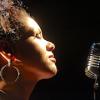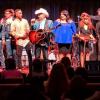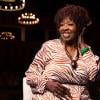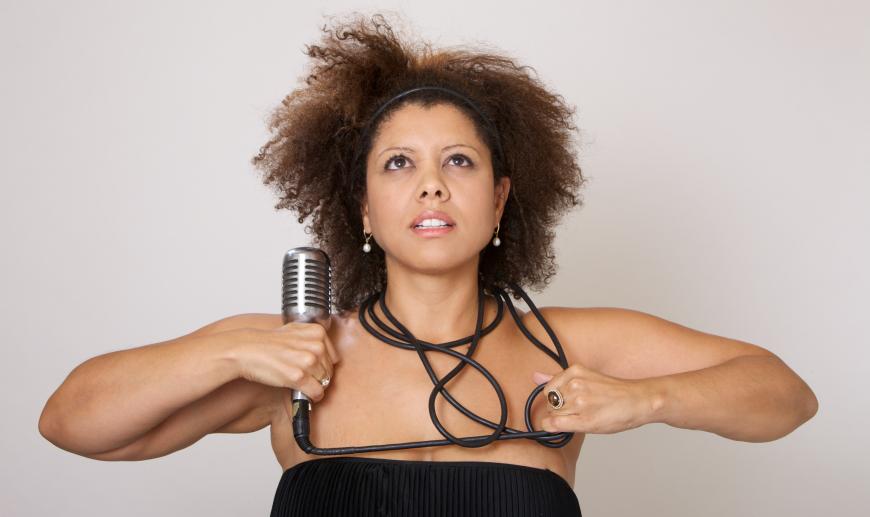
Jazz singer, historian, journalist, and activist Kim Nalley’s new album, I Want a Little Boy, lands on the ear like a call from a longtime friend. Co-produced with the inestimably upbeat tenor saxophonist Houston Person, the 10-track album delivers songs about human relationships in all their complexity. They are joined by stellar pianist Tammy Hall, bassist Michael Zisman, guitarist Barry Finnerty, drummer Kent Bryson, and, on the title track, Maria Muldaur.
Nalley grew up in New England and studied piano and classical music. Coming to the Bay Area in the 1980s, she sang in clubs, worked with the San Francisco Symphony, performed at jazz festivals, and, during a five-year tenure as owner/director of the club Jazz at Pearl’s, established a powerful presence as an authoritative singer and band leader. Nalley’s more than three-octave range is only surpassed by the diversity of her song repertoire. Crooning ballads, keening blues, scatting, swinging, growling, all without amplification — her voice can do anything, but as often as not, she chooses simplicity. In an interview, Nalley says the audience is like a member of the band and might cause her to switch gears — or change the evening’s planned setlist.
This month, she headlines the final concert at the Mendocino Music Festival, backed up by the Festival Big Band — Saturday, July 23, in Fort Bragg’s Cotton Auditorium (tickets here). In addition to singing, Nalley is a playwright (Ella: The American Dream) and a noted journalist and scholar who has written articles and academic papers about jazz history. Her dissertation, earning a doctorate in 2021 at UC Berkeley, was GI Jazz: African Americans as Artists and Occupiers in Post-World War II Germany.
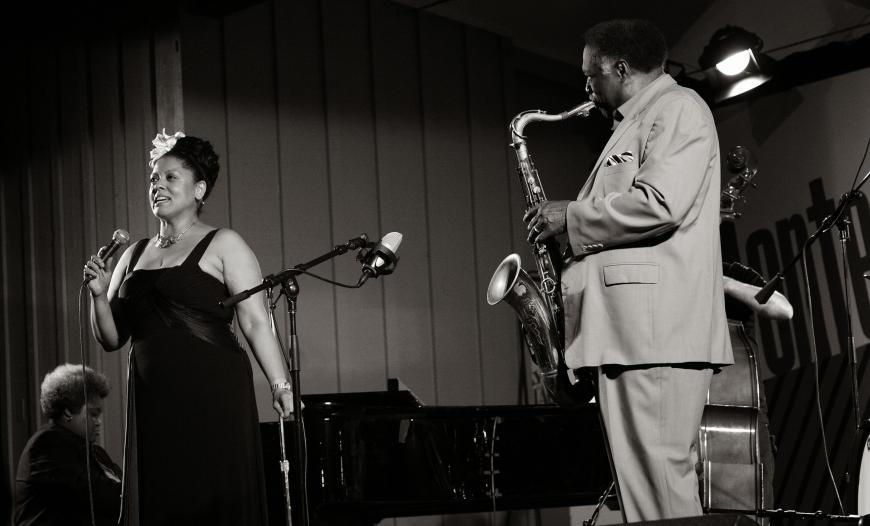
On the phone, we discuss the new album, but the rare opportunity to talk with Nalley more generally about jazz is irresistible, and our conversation swings open to include her discoveries, thoughts, predictions, and plans in 2022.
Let’s jump straight in and talk about a few tracks on your new album. I’m thinking about “Try a Little Tenderness.” What is your relationship with that song?
Oh my, I learned that song because of Maureen Miller, who was the chair of the UC Berkeley history department. Things were just so terrible during the Trump era, and people were turning on each other, and she asked me to sing it for graduation. She knew everyone was going through their own battles. I knew the tune, and when she said it was the right song, I said, “Yeah, you’re right.” I’ve kept it in my repertoire since then.
I brought a lot of tunes to the album that we’ve wanted to do for decades and had opportunities to play together but never had put on an album. Houston is so open and wonderful at putting tunes together. Some Black people accuse Elvis of appropriating, but Houston is more about connecting to all people and says it’s a good tune and maybe it will bring people over. We picked tunes that would appeal to a lot of people, tunes we might do in a different way so you could understand the lyrics better. It’s an album to make people feel included and better in some ways.
“Crazy He Calls Me”: What can you tell me about the shading and color in your approach?
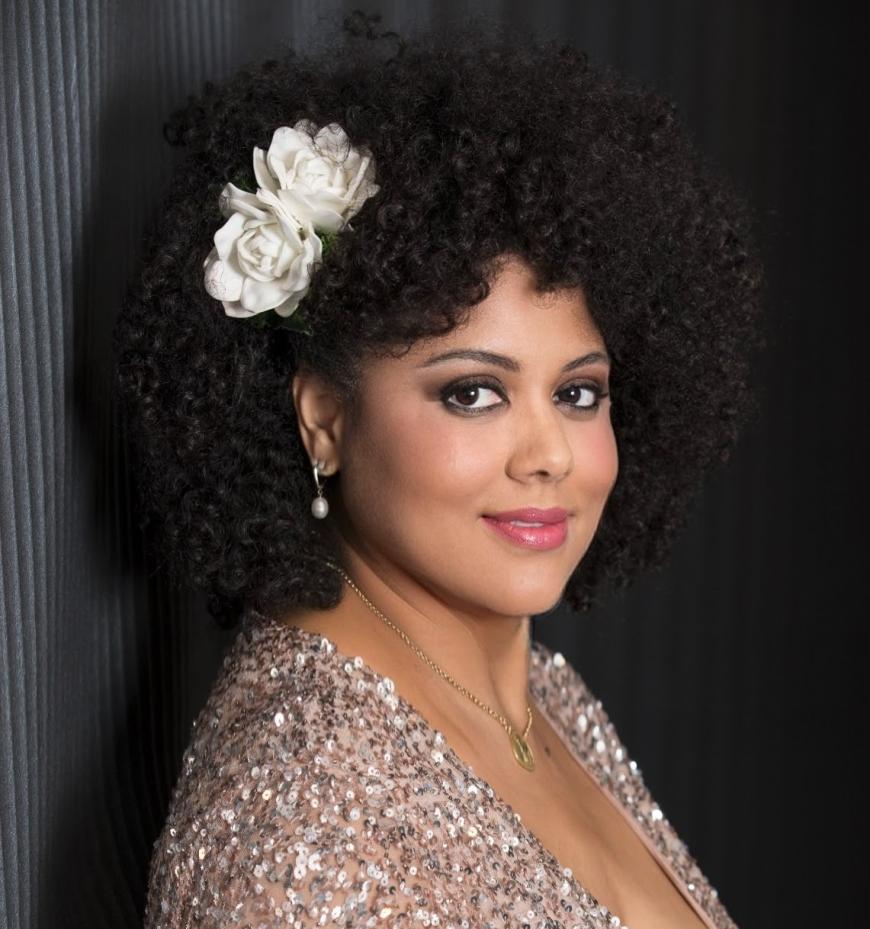
Sometimes people don’t like that inside of my singing: I make different sounds and colors. Classical music is supposed to have one tone all the time, and I don’t like that. That’s my husband’s and my song; I sang it at our wedding. I like to shade the endings on the lyrics and the chord changes. There are chord changes like “’Round Midnight”; you know my key is C minor, but it’s too happy, so I do it in B-flat. It’s darker and gives the right frequency on the right lyrics. When I pick my keys, it’s about what chord is being played on which lyric and which note. And how does that sound in my voice. Despair sung in my head voice is just not as good as chest or lower. I’ll change keys radically based on that. People don’t understand that singers do this. It’s not about what key I sing in, it’s how to make songs be more artful and people feel more emotions. If people cry once during my concerts, I’ve done my job. If I make them laugh once, I’ve done job.
“Teardrops From My Eyes”: Can you sing it without dancing? Especially during the instrumental breaks/interludes?
Oh my goodness, I love that tune for dancing. We did it in a way so it would be great for dancers. Houston and I feel dance is an essential part of the experience. [It’s part of] an African aesthetic that says music is about song, voice, and dance. The thinking that it’s not art if you’re dancing is a European, classical-music aesthetic I’m not into. This song is a Ruth Brown tune, and I’m definitely influenced by both her younger and her later years. She almost sounds like a different person with her older voice that has a different set of pipes, and you hear her singing around what she’s got. We only have one reed in our instrument, and it gets older and thinner with age. She still sounds great. She was the sweetest person and would remember me every time she saw me and would invite me backstage.
“I Want a Little Boy”: Listening to the duet version with Maria Muldaur is dynamic, but again, it’s so simple.
It is very special. I knew Maria because we’d done several benefit shows together. But I’d never asked her to do anything with me before. … She’s definitely one of my idols. It was so fun working with her, and we’re going to do more stuff at the Monterey Jazz Festival: some tunes she sang with the Jerry Garcia Band and a gospel tune, “I’ll Be With Thee.” As for why this song, I like bawdy, double-entendre tunes, and this is one of those songs that needed to be updated. You can’t, as a man today, sing this song anymore. The original is “I Want a Little Girl.” … But if you’re a man and get up there and sing, “I want a little girl, to call [my] own,” and she’s got to cook and clean? Uh-uh, that ain’t flying. If I sing it, with the changed lyrics, it’s more of a political commentary. I love that song. Lester Young has a version with great licks in it, and the wonderful Etta James sang it.
Tell me anything you’ve come to understand about your voice by listening to saxophone players, as well as by performing music written by singers.
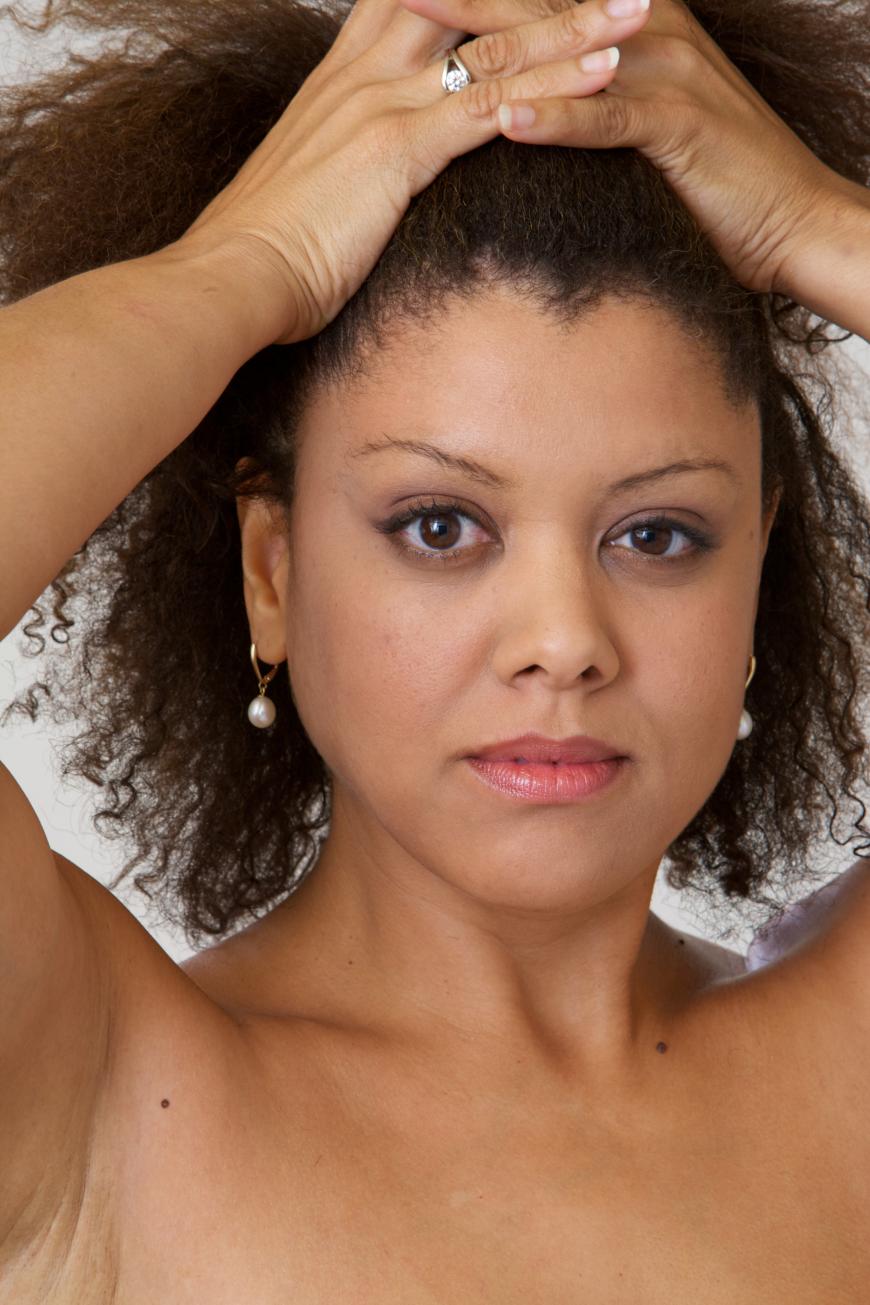
The first thing inside of jazz is that there are standard songs that were sung by different singers and were on the charts at the same time. Most laypeople will think, “Oh, this is a Billie Holiday song,” but at the same time, Ella Fitzgerald, Frank Sinatra, and others sang the same song. I look at songs as having different approaches by different singers. Let’s say Dinah Washington is singing a Bessie Smith song, and Billie Holiday is singing a Bessie Smith song. They won’t sound the same. I’m informed by a lot of different people including … Judy Garland, Nancy Wilson, Marlena Shaw. … Phyllis Hyman is a wonderful jazz singer you never hear about. When I came of age, Dianne Reeves had just done her debut album, and Cassandra Wilson had come out with her album. All of these things, and the entirety of Black women singers, inform my singing, but I didn’t learn by listening to other people. I learn by listening to myself. I learn by singing and finding what works for my voice.
What have you learned from Kim Nalley recently?
Recently, I’ve gone through a surgery. Every time I have had a surgery, I talk to the anesthesiologist and emphasize the importance of my voice. I haven’t had another job except as a musician. Some people think it’s just a hobby. I say, “Please use the smallest tubes and be very careful.” In the beginning of coronavirus, my vocal cords got nicked by a tube. I had a really hard time, and I wasn’t sure if I was ever going to get my voice back.
With hormonal changes and fertility treatments, my voice was already changed, and if you look at songs I’ve released, you’ll notice I have put out two different versions of the same song, “Trouble of the World.” One, my voice is regular, and the other [is from] when [I was] taking [a hormone]. My voice sounds very different. It’s almost like a young boy’s voice, very high and almost no vibrato. You don’t hear a lot about damage to vocal cords from surgery. Fortunately, it happened during COVID, and I didn’t have a lot of gigs and could rest my voice.
In what ways does your work as a historian and scholar extend into your approach to singing and your life as a performing artist?
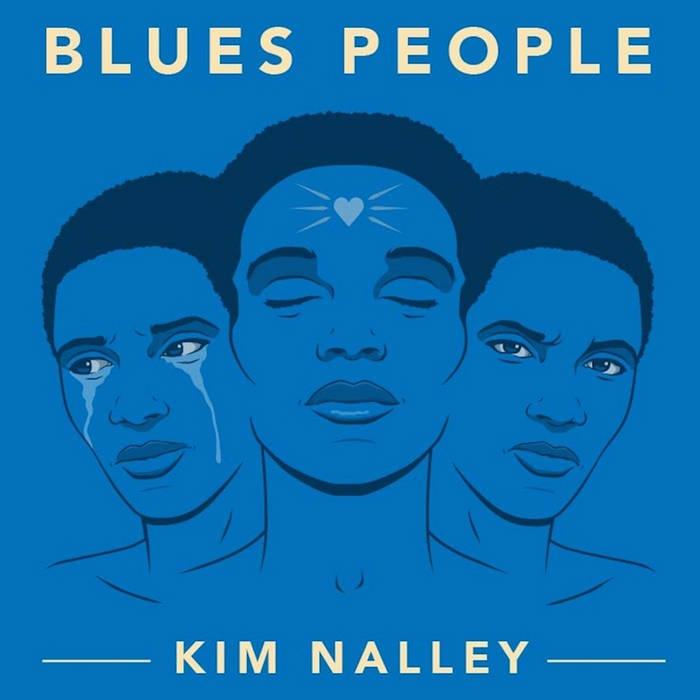
It informs my writing of original songs. I draw on historical material. When I sing the songs, I introduce them with historical patter as opposed to comedy. I use stories based in cultural and social history. It also helps me understand the lyrics a lot more. Certain things, if you are older, you understand, and if you’re younger, you might not. Like [the phrase] “hang up the phone,” young people don’t realize there was a phone you used to hang up on a wall.
I learn from history a lot about what people go through to get the gigs. There are a lot of disgruntled musicians out there who mimic attitudes of Black jazz musicians during segregation, but they’re white middle-class people. It’s annoying to me. They’ve absorbed the broad cultural politics that are not applicable to them. Jazz is only one percent of the market, so there’s only so much time and space for jazz musicians because it’s no longer [considered] popular music. Nobody is entitled to a right to make a living as a musician, or in any field.
Similarly, does your work as a writer cause you to focus primarily on lyrics and language and storytelling when you choose songs?
For me, the history helps me understand the lyrics better. But choosing my songs for a set is based on the energy of the audience. Sometimes I’ll have a set theme, but even within that theme, I might change on the drop of a dime. Fortunately, I have wonderful musicians that are able to roll with the punches and change songs. I always feel the audience is one of the members of my band, and I can feel what people need at that time. It’s more of a feeling than a quantitative or qualitative study. Sometimes audiences need to be brought up or want to cry or be ribald. If the energy of the room changes, I can shift. That’s what I enjoy in jazz. I can’t do that in classical music, musical theater, even in pop music, but you can do it in jazz.
Applying those concepts to your new album, what thoughts do you have?
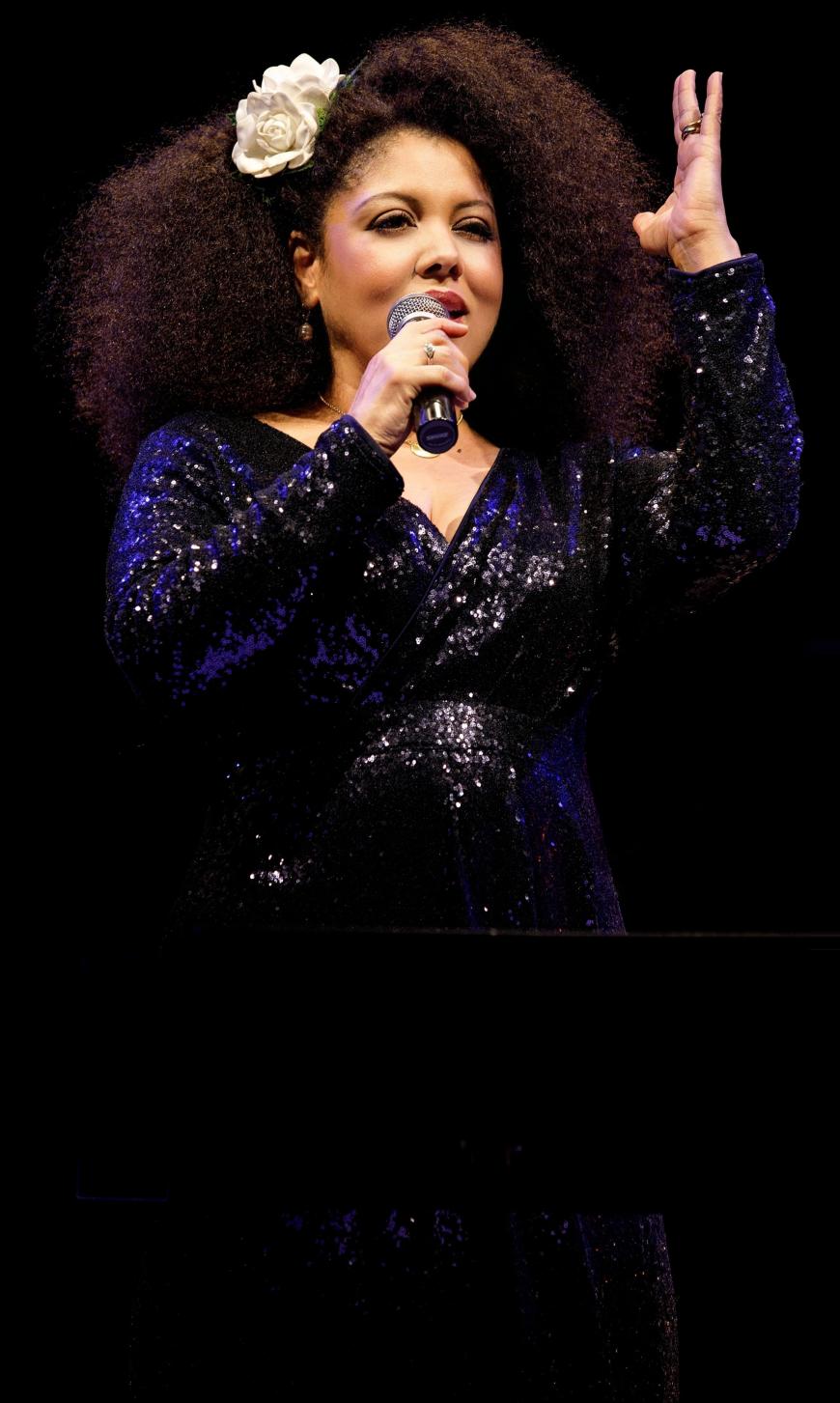
You and I grew up in an LP era, and now we’re back to singles, which is where the industry started, so what we were used to was in some ways just a blip in time. But I still think of songs in a certain order, especially when I’m singing live. The first tune needs to be something easy, so my voice warms up, something the band moves well and is mid-tempo in a good key. Then after two songs, I can do a ballad with more range. That’s my time to get the audience on my side, to grab them and hold them like a baby and rock them into another world. From there, I can do more up-tempo, more vocally difficult songs. Those first three songs either make or break a set. And the last song, you got to end on a great note. I have nightmares of the last tune breaking up and falling apart. It means I can’t leave the stage and have to keep singing, and then they’re closing the place and everyone’s leaving, and I have to keep singing until I get the closer.
Black women singers figured in the Black Power movement, in the Black Lives Matter movement, not just in music history or the history of the Black church. Do you believe Black women singers are recognized? Is there progress?
In the jazz industry, there is a tendency to denigrate blues, soul, and gospel as not being as advanced. Black people who sound like jazz are not perceived as being on the same level. Now if a white person does it, it’s so good because, “Oh, they sound so Black.” They think it’s a marvelous thing if a white person can sound Black. But if a Black person sounds Black, they’re just resting on their laurels or their culture. Because of this, if you look at DownBeat’s rising stars, the top of the charts are dominated on the critics poll by Black women who are pretty much not jazz. They’re doing something cutting edge, maybe hip-hop, soul, maybe avant-garde, maybe they’re someone well known. If you look at white singers, they are allowed to just do classic, vanilla jazz. A Black person who does that is not being innovative, but plenty of white singers do that, and no one says anything. It’s singers from Jane Monheit to Diana Krall to Stacey Kent. It’s still that Black people are supposed to innovate the culture and then be copied by white people. We put them in a box they can’t get out of: You’re expected to sing gospel, to sing the blues.
My background was being raised in the Catholic Church. It was full of “Ave Marias” and Handel Messiahs. There’s an expectation of uniformity inside of Black people and the Christian gospel church, and it’s not true. The culture is great with calls to prayer in a minor scale, similar to not just North African or Middle Eastern music but close to flamenco and North Indian music scales. Black culture is not a monolith.
Music as political protest or as activism: Is this a mantle you as an artist accept as burdensome, joyful, liberating, necessary, or something else?
I do a lot of political music, that is for sure. I’ve written intensely political songs, and I sing political songs from other generations. What I’ve noticed is we are excited to hear the old stuff because there’s enough distance to tell what is right and wrong. But the stuff that is about right and wrong now, people get testy. If I sing “Why? (The King of Love Is Dead)” by Nina Simone, about Martin Luther King, everyone can rally around and say he was really great. But during his time, he had really negative approval ratings. It wasn’t clear cut. People forget about that. People want to hear “Strange Fruit,” but then you go back and really think about it, and lynching was terrible. Vigilante justice is heartache to the American psyche. When I sang “Big Hooded Black Man” after Trayvon Martin’s death, people had a problem. That album didn’t do well until George Floyd died, then everybody was able to receive the message. They revoted the album, and I started getting played again. Especially because, [when it first came out], we had a Black president, everyone said, “Don’t say that. We don’t want to hear it.” In five years, things changed radically, and our psyche changed.
As a Black woman, just waking up in the morning is a political statement. My hair is natural, a bold statement because there are no federal protections for Black women to wear their hair the way it grows out of their heads. They can make somebody straighten or cut it off inside the aviation [industry], military, and other places. It’s not considered professional, which is straight and pulled back into a ponytail. Three ounces of conditioner would do my bangs but not my whole head. All of these things are intensely political in the lives of Black people in America. It’s terrible. It gets me sad and down that I’ve worked so hard and accomplished so much and that’s not necessarily recognized and compensated accordingly.
Acknowledging that Black women singers in history and current times are not a monolith, who today stands out as someone you find yourself listening to and admiring for her individuality?
There is one singer who’s the best I’ve heard, dead or alive. Her name is Camille Thurman, and I’m so shocked she’s not at the top of the list. Her instrument is like Sarah Vaughan on steroids. She plays sax as well, and she just navigates through low notes into midrange and into her head and falsetto flawlessly. No one on that A-list is anywhere near her.
What do you hope to do next?
I need to finish writing this book. I’m turning my dissertation into a book, and I’ll take a sabbatical to do that. I’ll take a sabbatical from the stage, too. I’ll come back, but there’s so much about singing and the music industry that’s not onstage. They see that 90-minute show and don’t understand it takes hours and hours of preparation and practice and hours and hours of press and social-media commitments to make it happen. I can’t concentrate on the book unless I pull back and get it done.


